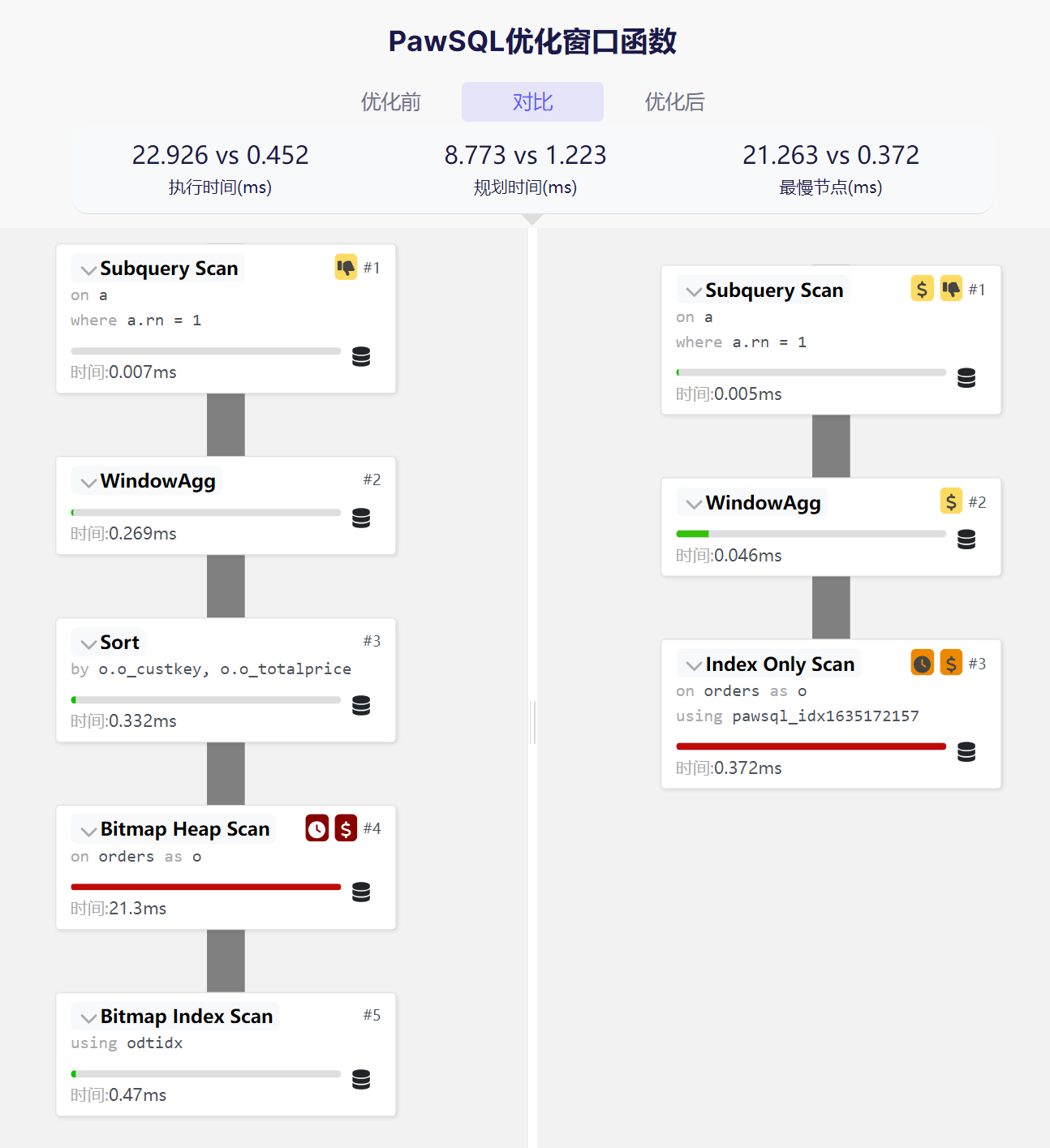PawSQL's Smart Index Recommendation Helps Improve Window Function Performance by 50 Times
🌟 Introduction
In the data-driven modern world, SQL query speed is key to rapid application response. Especially for complex queries involving window functions, performance bottlenecks can become an obstacle without appropriate index support. This article will explore how PawSQL significantly improves SQL query performance for window functions through intelligent index recommendations.
🔍 Case Analysis
Through a practical case, we will demonstrate how PawSQL optimizes a query containing window functions.
📝 Original Query
SELECT *
FROM (
SELECT o.o_custkey, o.o_totalprice,
RANK() OVER (PARTITION BY o.o_custkey ORDER BY o.o_totalprice) AS rn
FROM orders AS o
WHERE o.o_orderdate = '1996-06-20'
) AS A
WHERE A.rn = 1
This query aims to find the lowest order amount for each customer on June 20, 1996.
🎩 PawSQL's Optimization Techniques
PawSQL conducted an in-depth analysis of the query and proposed the following optimization recommendations:

🌈 Secrets of Performance Improvement
The optimization details page shows that the indexes recommended by PawSQL can improve query performance by approximately 5181.55%. How is this achieved?

1. Precise Index Matching
The new index PAWSQL_IDX1878194728 perfectly matches the query requirements:
o_orderdateas the first column supports rapid data filtering.- The combination of
o_custkeyando_totalpriceprovides support for window function partitioning and sorting.
2. Avoiding Sorting Operations
Since the index is already sorted by o_custkey and o_totalprice, the database can directly utilize the index order, eliminating additional sorting steps.
3. The Power of Covering Indexes
The new index contains all columns required by the query, achieving a "covering index". This means the database can retrieve all data directly from the index without accessing actual data pages, significantly reducing I/O operations.
4. Changes in Execution Plan

Before Optimization:
- Uses Bitmap index scan and heap scan.
- Requires additional sorting operations.
- Execution time: 22.926 ms
After Optimization:
- Uses index-only scan.
- No additional sorting needed.
- Execution time reduced to 0.452 ms
📚 Best Practices
- Regular Analysis: Use PawSQL to periodically analyze your queries, especially complex queries containing window functions.
- Balance Trade-offs: While the new index improves query performance, it also increases storage overhead and affects write performance. Real-world applications require careful consideration.
- Remove Redundancy: Promptly clean up old indexes covered by the new index, such as
odtidxin this example. - Holistic Perspective: Consider the query patterns of the entire application, and don't optimize individual queries at the expense of overall performance.
📈 Conclusion
PawSQL demonstrates how to significantly improve SQL query performance for window functions through intelligent index recommendations. By creating indexes that precisely match query requirements, we can substantially reduce execution time and improve application response speed. In the big data era, such optimization not only enhances efficiency but also saves valuable computational resources.
Remember, database optimization is an ongoing process. Regularly using tools like PawSQL for analysis and optimization will help keep your application in peak performance condition.
🌐 About PawSQL
PawSQL is dedicated to automatic and intelligent database performance optimization. The products provided by PawSQL include:
- PawSQL Cloud, an online automated SQL optimization tool that supports SQL auditing, intelligent query rewriting, cost-based index recommendations, suitable for database administrators and data application developers.
- PawSQL Advisor, an IntelliJ plugin that is suitable for data application developers and can be installed via the IDEA/DataGrip marketplace by searching for "PawSQL Advisor" by name.
Contact Us
Email: service@pawsql.com
Website: https://www.pawsql.com
